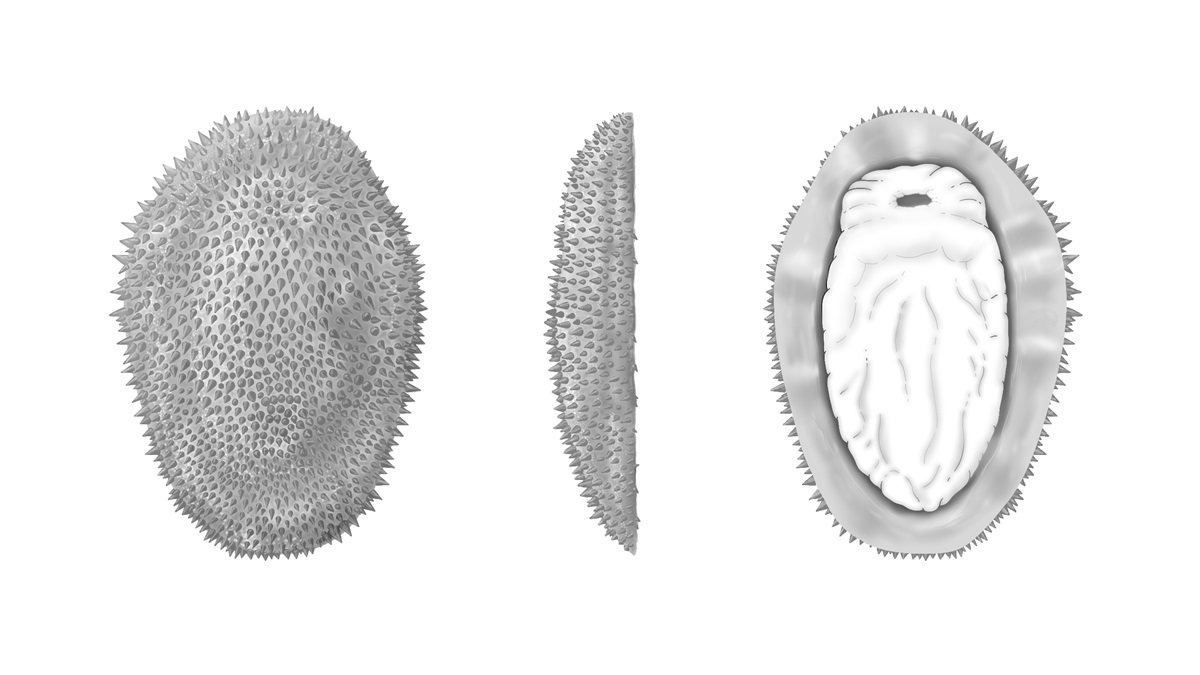A new species has been identified from a 514-million-year-old fossil found in China’s southern Yunnan province.
Shishania aculeata is an ancient slug with a twist. Its fossils reveal that the world’s earliest molluscs were armoured creatures. Unlike the snails of today, however, these early molluscs didn’t have shells.
Research published in the journal Science shows that S. aculeata was covered in hollow, cone-shaped spines.
The spikey cones – called sclerites – were made of chitin, the same material found in the shells of modern crabs and insects.
S. aculeata were only a few centimetres long. They were flat slugs with soft undersides.
Today Mollusca is the second largest invertebrate phylum within the animal kingdom. Species range from octopus and oysters to snails and slugs.
This wide variation of shape, size and lifestyle has led scientists to long consider what a hypothetical ancestral mollusc would have been like. Previously, palaeontologists hypothesised that the common ancestor of Molluscs had a single shell like a limpet.
“Trying to unravel what the common ancestor of animals as different as a squid and oyster looked like is a major challenge for evolutionary biologists and palaeontologists – one that can’t be solved by studying only species alive today,” says corresponding author Luke Parry from the University of Oxford, UK.
“Shishania gives us a unique view into a time in mollusc evolution for which we have very few fossils, informing us that the very earliest mollusc ancestors were armoured spiny slugs, prior to the evolution of the shells that we see in modern snails and clams.”
Soft body parts do not fossilise easily, making the S. aculeata specimens difficult to study.
“At first I thought that the fossils, which were only about the size of my thumb, were not noticeable, but I saw under a magnifying glass that they seemed strange, spiny, and completely different from any other fossils that I had seen,” explains first author Guangxu Zhang from China’s Yunnan University.
The fossils were identified as belonging to an ancient mollusc. Its tiny features were analysed using a variety of techniques including X-ray fluorescence and visible light microscopy.
“We found microscopic details inside the conical spines covering the body of Shishania that show how they were secreted in life,” Parry adds. “This sort of information is incredibly rare, even in exceptionally preserved fossils.”
Shishania’s spines were produced in an internal system of canals less than a hundredth of a millimetre across. The cones would have been secreted at their base by microvilli, groups of cells like a natural 3D printer.
Such sophisticated secretion systems are shared by Shishania with annelids such as earthworms.
Hard parts on today’s molluscs are no longer made of chitin, but calcium carbonate – the main ingredient in chickens’ eggshells. But it appears that these hard mollusc parts had there start with the chitinous spines of molluscs like Shishania.
“These animals are very different from one another today and so fossils like Shishania tell us what they looked like deep in the past, soon after they had diverged from common ancestors,” says Parry.
Shishania appeared early in the Cambrian period (539–484 million years ago). The Cambrian saw an evolutionary “explosion” of life and the emergence of all the basic body plans of animals we see today.
“Molluscs today are extraordinarily disparate and they diversified very quickly during the Cambrian explosion, meaning that we struggle to piece together their early evolutionary history,” says co-author Jakob Vinther from the UK’s University of Bristol.
“This new discovery highlights the treasure trove of early animal fossils that are preserved in the Cambrian rocks of Yunnan Province,” adds co-author Xiaoya Ma from both Yunnan University and the University of Exeter in the UK. “Soft bodied molluscs have a very limited fossil record, and so these very rare discoveries tell us a great deal about these diverse animals.”














/https://tf-cmsv2-smithsonianmag-media.s3.amazonaws.com/filer_public/d1/82/d18228f6-d319-4525-bb18-78b829f0791f/mammalevolution_web.jpg)






Discussion about this post